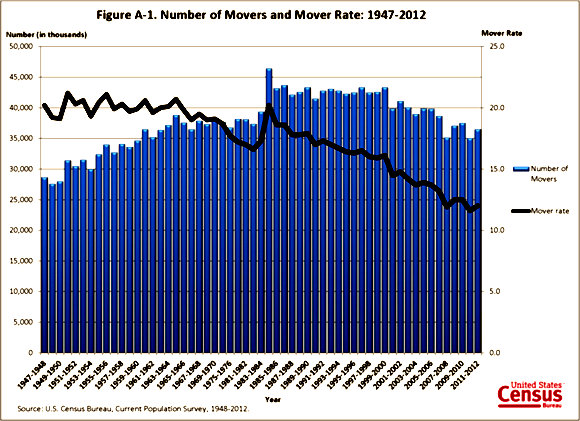To link to this article from your blog or webpage, copy and paste the url below into your blog or homepage.
HOUSING AND MOVING
an article by our site
HOUSING AND MOVING
Type Of Living Arrangements from 1983 to 2012
Housing Vacancy Rates In The U.S. from 1983 to 2012
Rural, Urban, and Suburban Population from 1983 to 2012
HOUSING AND MOVING
The statistics tell us that Americans have always been on the move. The fact that we're quite used to uprooting ourselves dovetails positively with the formative stages of the MC movement.
Work-related and financial-mobility reasons have, in the past, been the primary reasons for moving. People rarely move to be near friends, and only occasionally do people move to be near relatives. There has been little about friendships or closeness to relatives that has motivated anyone to stay in a particular neighborhood or town.
There will be a lot of moving while MCs are first forming. The greater the number of people planning to move to an MC, the greater the number of vacancies. Therefore it will be much easier and quicker for everyone to move to a new location. For the first time in most people's lives, they will be moving toward something meaningful, toward a sense of community and connectedness that they never had the opportunity to choose before.

According to a 1985 survey of 44,000 households, conducted by the Census Bureau, a typical householder last moved 5 years and 9 months ago. In 2009, 12.5 percent of people in the U.S. moved, which is a rate of once every 8 years—people are moving less, because of the recession, the burst housing bubble, and joblessness. However, the age of the homeowner has a lot to do with moving, with the average length of residence increasing with age. The median age for movers is 27 years and the median age for nonmovers is 41 years. Renters move 4 times as often as homeowners with a median of 20 months in their current home compared to 114 months for a home owner. However, it should be noted that about one fifth of renters move to become homeowners. These moves account for about 48 percent of all moves made by homeowners.
By region, people in the Northeast had the lowest mover rate (8.1 percent), followed by the Midwest (11.6 percent), the South (13.7 percent) and the West (14.8 percent).
Mortgage rates have a significant effect on the moving rate. In 1982-83 when mortgage interest rates were at historic highs and the nation was in a recession, the moving rate reached a low of 16.6 percent. Prior to that (in the 50s and 60s), the rate averaged about 20 percent. The rate returned to 20 percent in 1985, as interest rates fell. It has remained below 20 percent since—as low as 11.9% which happened in 2008. (Source: Long, Larry, "Americans on the Move," American Demographics, June 1990, pp. 46-49.)

Moving
In a 5-year period (1980 to 1985), two fifths of all Americans changed residence with 57 percent of renters and 40 percent homeowners moving. (Source: Current Population Survey, U.S. Bureau of the Census, 1983, 1986.) Between March 1986 and March 1987, 43 million people (householders and their dependents) moved. (Source: "Most Moves are Local," The Numbers News, June 1989, pp. 3-4.) The biggest move was within the suburbs with 12 million suburbanites moving to another suburban home. Eleven million city dwellers moved to other city homes, with 80 percent remaining in the same city. Nearly 1 million people left rural areas for either cities or suburbs. (Source: "On the Move," Report to Retailers, August 1989, p. 2) The patterns are similar close to 2010, except the percent of movers per year has sunk to record lows; i.e., 11.9% in 2008.
Twenty-six percent of movers have moved 3 or more times in a span of 3 years. (Source: National Health Interview Survey)

Surveys are great marketing, sociological, and demographic research tools
Most people who move go only a short distance, a median of about six miles. This distance has been about the same for the last 40 years. (Source: Long, Larry, "Americans on the Move.")
About a quarter of American adults between the ages of 18 and 30 now live with parents, while intergenerational households have reached the highest level in more than 50 years. So it’s easy to see that relocation has a lot of different possible explanations. (Source: Young U.S. Adults Flock to Parents’ Homes Amid Economy, Bloomberg.com, by Kathy Warbelow & Frank Bass, 2012)

HOUSING AND MOVING
Type Of Living Arrangements from 1983 to 2012
Housing Vacancy Rates In The U.S. from 1983 to 2012
Rural, Urban, and Suburban Population from 1983 to 2012
You're probably thinking how difficult and inconvenient it is to relocate. Yes and no. The best-case scenario is a big city where the relocation does not involve leaving jobs or friends. Instead, the commute changes and the friends have to drive, walk, or mass transit to a different area of the city. Even though in small towns the chances of you locating (with Register for MC Search and Match) extremely compatible people to be in an MC with are tiny, in a big city they're good. There are so many possible choices. Over half the population of our country lives in the suburbs, a third live in urban areas, and only a sixth live in the rural areas. And in 2010, 15 million U.S. housing units (11.4 percent) were vacant, so there are plenty of unoccupied places to move to.

Registering for MC search and match
You ask: WHY Register for MC Search and Match?. You'll know after reading "WHY Register for MC Search and Match?" and checking out all the drawings of MCs.
Anyway, the best-case scenario is several families moving in a big city with accompanying commute changes, but no need for job or "casual friends" changes. You will have new neighbors—your MC will contain the best friends you have ever had. You may miss your old neighbors, but nothing stops you from contacting them or visiting them or vice versa. There's even a chance that you need not move, and that all new MC members relocate to your neighborhood since many houses happened to be for sale. There's also a chance that you are very compatible with one or more of your current neighbors and you both stay put or relocate to the same MC elsewhere in the city. There's even a chance you can talk one of your current neighbors into moving by doing the work of finding them a location they prefer to their current one—present an offer too good to pass up.
For more about getting jobs and what jobs to get and telecommuting and jobs in general, check out the Jobs section of relocation.





